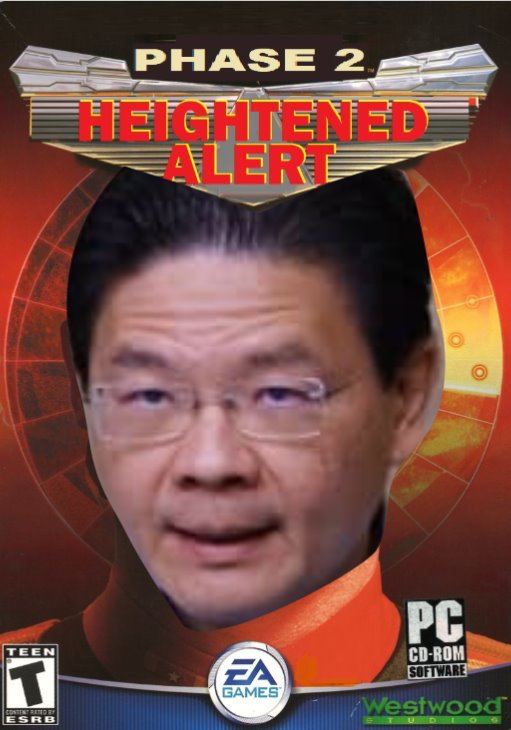There are many names for what Singapore is going through at the moment. Circuit Breaker in all but name. Phase 2: The Empire Strikes Back. Déjà vu. A lockdown with Singaporean characteristics.
Take your pick, but officially, it's known as Phase 2: Heightened Alert (P2HA), which resulted in at least one glorious meme, for those of us who spent endless hours playing "Command & Conquer: Red Alert" back in the day.
 Kirov reporting.
Kirov reporting.
Here's a handy comparison chart for what you can and cannot do during P2HA:
Notice something? PH2A is much more "easy-going" as compared to the Circuit Breaker. Retail shops are open, you can buy 4D and Toto, and perhaps most important of all, bubble tea shops are open for takeaway orders (although some have closed).Back on May 4, when now-Finance Minister and Covid-19 multi-ministry task force co-chair Lawrence Wong announced the latest measures, he said that the government is not ruling out the possibility of another Circuit Breaker.
More infectious variant this time round
The most pertinent reason for a full lockdown, similar to the 2020 Circuit Breaker, is that we're not dealing with the virus of 2020. It has mutated and evolved, and the B.1.617 variant first detected in India, and seen in some Singapore cases, is much more transmissible.
David Lye, director of infectious disease research at the National Centre for Infectious Diseases (NCID) said as much in a message that was widely circulated online.
According to Lye, the situation in 2021 could be more dangerous than what Singapore faced just before the Circuit Breaker.
Although today we have expanded testing capacity and are progressively vaccinating the population, the mutant strain has proven infectious enough to "break through" our defences.
It rapidly infected Changi Airport and Tan Tock Seng Hospital workers despite masks and vaccinations, although those vaccinated avoided serious illness.
Changi Airport is now Singapore's largest active Covid-19 cluster in less than a month, with 108 confirmed cases as of May 28.
With that in mind, a full Circuit Breaker would minimise human contact as much as possible.
A three-week Circuit Breaker, in line with the recent updated guidelines mandating an extended Stay Home Notice for travellers from high-risk countries, would help to break the chain of infections in the community.
Stop errant companies from making employees return to the office
Although working from home (WFH) has been mandated as the new default, there have been scattered complaints online where Singaporeans share that their bosses have asked them to return to the office during P2HA.
On May 24, the Ministry of Manpower announced that it had inspected 530 workplaces and issued fines to 11 companies who did not ensure WFH as a default working arrangement.
While 11 out of 530 is an admirably low percentage, it's still concerning that 11 companies thought they could flout the P2HA rules.
The Straits Times spoke to workers who said that their companies insisted they be treated as essential workers, even though their duties could be mostly done from home.
Perhaps these companies mistakenly believe that P2HA is "less serious" than the Circuit Breaker, as people are still free to move around while not at work. If a Circuit Breaker is implemented, maybe employers will get the message that this is just as serious.
Businesses don't want to be stuck in a "zombie" situation
But what about the businesses if there is a CB, you might ask.
One big difference about P2HA is that non-food retailers are still allowed to open and do business, although abiding strictly to safe management measures.
You might think that businesses would oppose a full Circuit Breaker. However, some are instead calling for one instead of the current "zombie" situation.
According to retail tenant group Singapore Tenants United For Fairness (SGTUFF), which has over 700 members, it may be better than having the government implement progressively tighten measures.
In a Business Times article on May 17, the group noted that while malls remain open, they have turned into "ghost towns." Of retailers who have seen a decline in sales, 45 per cent have experienced a drop of 80 per cent.
A spokesperson said:
"With infections going up, we think it's more straightforward for us to go into CB instead of facing the current zombie situation for non-F&B (food and beverage) businesses. Many members in retail and other non-F&B services are also facing severe business drops like those in F&B, but they have not been offered the 50 per cent JSS (Jobs Support Scheme) help or rental reliefs."
A few retailers did say they prefer to keep their shops open despite the lack of footfall, but most told BT that most shoppers buy food and head straight home instead of walking around to shop.
Other tactics to drive up traffic, such as announcing a sale, would be counter-productive from a health standpoint as this would result in crowds and queues. And keeping the doors open means paying for operating costs, such as utilities and rent.
Current measures may be working
Given these public health and business concerns, it might seem perfectly reasonable to call for a Circuit Breaker and break the chain of infections, but it would be remiss not to factor in other considerations.
The current situation, while not the most ideal for businesses, appears to have already made a positive impact in our fight against Covid-19.
Singapore will likely not embark on "further tightening" of prevailing measures to curb the spread of Covid-19, Wong said on Friday, May 28.
The current measures in place for the P2HA period have been working as the number of new community cases has stabilised, Wong added, saying there is no need for further tightening "in our overall posture" for now.
At what cost?
At the end of the day, everything comes with a cost.
We just need to look at our neighbour to the north to get a sense of how incredibly draining getting people to remain indoors can be for the national coffers.
In a surprisingly candid television interview, Malaysian Prime Minister Muhyiddin Yassin said that the government considered implementing another full lockdown to deal with a surge in cases, but it could not afford it.
Muhyiddin said that he did not want the national economy to "collapse" and the previous lockdown (called a full Movement Control Order in Malaysia) cost the country around S$770 million a day. Not just in financial support, but also the loss of economic activity as people stayed indoors.
Muhyiddin shared that the government rolled out a stimulus package of around S$109 billion to help the economy, but he doubted that the same amount would be able to help the country this time round, due to the sharp rise in community cases.
He rhetorically asked if Malaysia could afford an even bigger package if another lockdown was imposed.
While circumstances are different in Singapore, the fact remains that we also spent a tremendous amount of money to help support workers, businesses and the public to help fight the economic fallout of Covid-19, and not just the health measures.
In 2020, the year of an unprecedented Four Budgets saw a price tag of S$92.9 billion in Covid-19-related expenditure. Another S$8 billion was announced in the August Ministerial Statement.
While Singapore's vast reserves helped to stave off economic disaster, they are not inexhaustible.
Announcing another Circuit Breaker would require even more financial support for businesses and workers. While we may be able to pay for another round of measures, that leaves less ammunition to deal with the next crisis that may rear its head.
Already, a new S$800 million support package was extended to businesses and workers amidst tightened Covid-19 restrictions yesterday (May 29).
We may never eradicate Covid-19 completely
Like disco music and cockroaches, we may never be truly free of Covid-19.
Although the ideal situation is to see it blasted off the face of the Earth permanently, we may need to establish an uneasy detente whereby it exists in some form in society, but it does not completely disrupt day-to-day life.
Wong alluded to this during the January Institute of Policy Studies discussion, where he said that the pandemic may take four or five years to pass.
He also told the media on Friday (May 28) that Singapore has started planning for the possibility that Covid-19 may become endemic here.
Chris Witty, chief medical adviser to the UK government, said that society may have to manage the virus in a similar manner to other serious seasonal afflictions, like influenza.
According to The Guardian, he said:
"It is not flu, it is a completely different disease, but the point I am making is, here is a seasonal, very dangerous disease that kills thousands of people every year and society has chosen a particular way around it."
Of course, the flu is not as dangerous or disruptive as Covid-19, but Witty advised that society should work out a balance that keeps Covid-19 at a low level, minimises deaths and do much of the "heavy lifting" with medical countermeasures.
In Nov. 2020, White House Covid-19 adviser Anthony Fauci said he doubted that Covid-19 could ever be eradicated completely, and that while the pandemic might pass, it could remain endemic.
If this comes to pass, sounding the sirens and flipping Singapore into full lockdown mode anytime there's a spike in infections, kind of like the town from "Silent Hill", may not be the most practical route forward.
But for now, the option of a Circuit Breaker Part 2: Break Harder remains on the table.
Top image from SeeClips YouTube channel.
If you like what you read, follow us on Facebook, Instagram, Twitter and Telegram to get the latest updates.
